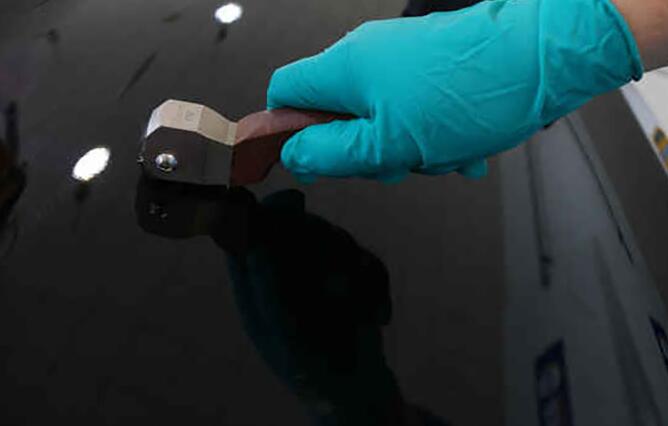Two Test Methods for Paint Scratch Hardness Testing
A coating is usually a very thin layer of material supported by a substrate, including waxes, lacquer/acrylic/enamel paints, and other types of materials applied to the substrate, which is resistant to moisture, weathering, contamination, oxidation, and corrosion.

In the coating industry, hardness is the determination of the ability of a paint film surface to resist scratching, damage or planing. For example, the scratch test is the automobile interior and exterior parts of the surface quality control of the conventional testing program, mainly to check the various automotive interior and exterior parts of the surface by hard objects (keys, coins, etc.) scratching and other environmental stresses when the change occurs. Laboratory commonly used scratch hardness test methods are pencil hardness method and scratch needle determination method.
I. Pencil hardness test
Coating film pencil hardness method is a commonly used coating film physical properties test method, can be used to assess the hardness of the coating film and abrasion resistance, this method is simple to operate, the instrument is small and easy to carry, not subject to site constraints to carry out rapid testing and other advantages. For many years, many coating manufacturers and some finishing workshops have been using the Dutch TQC Sheen brand pencil hardness tester VF2378 to measure and determine the scratch hardness of a particular coating film, in line with ASTM, ISO, JIS and GB/T6739-2006 pencil hardness test standards, to provide a standard load of 750g of the pencil hardness test instrument, according to the Wolff-Wilborn specification with 20 different pieces of pencil hardness test instrument. Wilborn specification is equipped with 20 special pencils of different hardness (8B~10H) to scratch the coating and then determine its hardness.
Of the 20 special pencils, 8B is the softest pencil and 10H is the hardest. During the test, a standardized scratch tester is used to scratch the pencil at a 45° angle along a certain length on the coating under test, and then the hardness level of the coating is determined according to whether or not the pencil can leave visible scratches on the coating. If the coating cannot be scratched visibly by the pencil, the pencil hardness level is gradually increased until the pencil is able to leave a visible scratch on the coating.
The Pencil Hardness Test for Coatings is usually applied when the hardness of the coating is relatively low, such as wood coatings, wall coatings, etc. The test is simple and easy to perform. The test method is simple and easy to carry out and does not require expensive test equipment, so it is widely used in industrial production and product quality control of coatings.
Second, the scratch needle method
Needle scratching method is to scratch the coating with the needle tip of the instrument, the stress generated when the needle is pushed on the paint film exceeds the elongation strength of the paint film and produces scratches, the hardness of the coating film is represented by the resistance of the coating film to scratching by the needle, and the coating is observed whether the coating is scratched by the ball point needle under the specified weight pressure, or the minimum load required for the scratching by the needle to scratches through the coating to indicate. Coatings laboratories typically use the TQC Sheen SH0530 Coating Surface Scratch Tester to evaluate coating hardness based on the scratch resistance method.
The SH0530 Coated Surface Scratch Tester operates the slide and test arm at a constant speed (3-4 cm per second). The tungsten carbide ball pins are fixed in the chuck of the test plate at an angle of 90° and can be easily removed for inspection and replacement, equipped with optional additional weights from 100g to 2kg (0-20N) loaded above the ball pins (or stylus), and for harder coatings, optional additional weight attachments up to 10kg are available. The instrument can be used with test specimens up to 1.65mm in thickness, 150mm in length and 100mm in width (specimens are usually metallic), but a customized service is available for special requirements.
The supporting arm of the test needle is force balanced and rigid structure, which can be prevented from being in the sphere, and the pivot of the weight holder is supported by ball bearings, which is flexible in rotation and reduces the friction torque, thus ensuring good repeatability of the test results. There is a voltmeter on the panel, when the paint film on the sample plate is scratched by the scratching needle, the voltmeter will indicate, so that you can determine whether the paint film has been scratched through, greatly reducing the error generated by human operation. Scratch hardness reflects the combination of modulus, tensile strength and adhesion, so the characteristics of the film hardness it determines are different from the pendulum damping test method.

